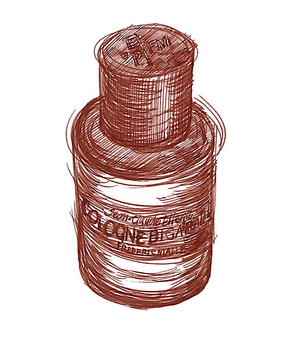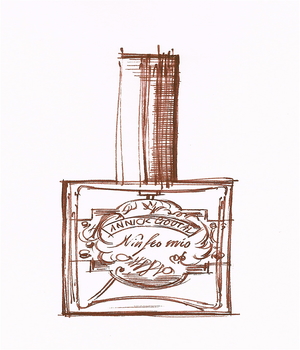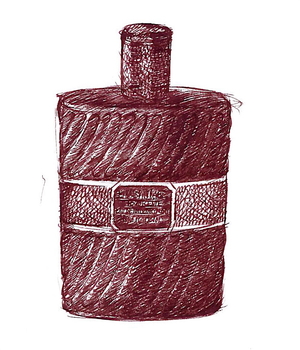Tagged With ‘sweaty’
Frederic Malle
Cologne Bigarade
10 January, 2015
 Every morning for my breakfast I have tea, toast and home-made marmalade. It’s one of my favourite things, and I love the bittersweet smell of Seville oranges, which only appear in the shops for a couple of weeks around this time of the year.
Every morning for my breakfast I have tea, toast and home-made marmalade. It’s one of my favourite things, and I love the bittersweet smell of Seville oranges, which only appear in the shops for a couple of weeks around this time of the year.
In fact as I sit here writing this post in January, Roy is busy cooking marmalade next door, and the powerful odour of bitter orange (known as bigarade in French) is suffusing the house from kitchen to attic.
So it could hardly be a better time to review Cologne Bigarade, created by the perfumer Jean-Claude Ellena for the French fragrance curator and marketeer, Frédéric Malle (nephew of the film director Louis Malle). Launched in 2001, it was one of the first of the Editions de Parfums Frédéric Malle, and to my mind it’s one of the most immediately appealing and easy to enjoy.
On first – I was going to say ‘glance’, but I suppose I should say ‘spritz’, it smells like a simple but high-quality natural scent, with the exact mix of sweet green freshness and slight bitterness that you get from orange peel and its bitter pith.
You could, I guess, just bottle Seville-orange extract and have done with it – and apparently Jean-Claude Ellena did commission a special new essence for this scent, obtained by molecular extraction. But like all good perfumes Bigarade Cologne is ultimately a clever recreation of what seems, on the surface, like a simple natural scent, using a careful balance of other ingredients to enhance and support the main ingredient.
In this case, Ellena has added a bit of hay and grass – or rather their synthesised essences – which makes the orange even fresher somehow, then subtly underpinned it with a little cedar-wood and rose, adding extra depth and staying-power. You could even say that these extra ingredients suggest the smell of the leaves and the twigs of orange trees, though perhaps that’s going too far.
(Actually, unless you concentrate very hard you can’t really smell them at all; but then we’re so suggestible when it comes to scents that once someone has told you that a particular ingredient is present, you’re more than likely to ‘smell’ it whether it’s actually there or not.)
To me Cologne Bigarade also has a very slight and not unpleasant sweatiness, which (from a short trip to the kitchen and back) is part of the authentic Seville orange smell. In perfume that faint sweatiness is often derived from cumin, and I wonder if there might be a touch of that classic curry spice here too.
Cologne Bigarade is not, perhaps, the most complex perfume on the market, but like most of Jean-Claude Ellena’s fragrances it’s rather more thoughtful and unusual than the general run. Given that he’s also the in-house perfumer for Hermès, it immediately made me think of Hermès’ classic Eau d’Orange Verte, which is also based on the scent of bitter oranges. Though that perfume was originally created by Françoise Caron in 1979, Ellena developed a new version in 2004 called Concentrée d’Orange Verte.
Eau d’Orange Verte is one of my all-time favourite fragrances, yet comparing them side by side, it smells sharper and fresher, but perhaps also slightly less interesting than Cologne Bigarade, which also seems to have much more staying power (a rare quality in a citrus-based cologne, though you can also find it in the fantastic sherbet-lemon Monsieur Balmain).
All the fragrances in the Editions de Parfums Frédéric Malle are expensive, and Cologne Bigarade is no exception, even if its packaging is extremely smart. The heavy, plain-glass bottle has a chunky black cap and comes in a slide-out, black foam-padded box, which in turn slides out (with some effort) of a scarlet card wrapper. If you have money to burn then there’s an even more expensive version called Bigarade Concentrée, which I’ve smelled as a sample and lasts even longer than Cologne Bigarade. The concentrated version also seems to have less of that faint sweatiness about it, which I suspect many people would prefer; I think I do too.
Either way, a fresh but unusual cologne is a wonderful thing to have, so full marks to Jean-Claude Ellena and Frédéric Malle for giving men something a bit different to wear. In a similar vein, though with a very different smell, is Malle’s Geranium Pour Monsieur, which I hope to be able to review before long; watch this space.
Annick Goutal
Ninfeo Mio
2 August, 2014
 This is the second time I’ve stumbled across a delicious perfume in, of all places, TK Maxx. I know I should be saving up and buying beautifully wrapped bottles from expensive boutiques, but for a start I don’t earn much and, second, I rather like the occasional gamble on a discounted scent that might just turn out to be fab.
This is the second time I’ve stumbled across a delicious perfume in, of all places, TK Maxx. I know I should be saving up and buying beautifully wrapped bottles from expensive boutiques, but for a start I don’t earn much and, second, I rather like the occasional gamble on a discounted scent that might just turn out to be fab.
That’s certainly the case with Ninfeo Mio, a small bottle of which I picked up for a song a little while ago. I’m a bit of an Annick Goutal fan, mainly for the powerful, love-it-or-hate-it Sables, but also for the better-known Eau d’Hadrien, so Ninfeo Mio seemed worth a bet – and I’m glad I took a punt.
This unisex perfume was launched in 2009 and created by Isabelle Doyen, who was Annick Goutal’s assistant, and took over the development of new perfumes after Goutal’s death in 1999. The first thing you smell is fig, and actually that’s pretty much the last thing you smell too, and that would be just fine and dandy with me, since fig is a scent I love – both the natural thing and figtastic perfumes like Premier Figuier from L’Artisan Parfumeur and Philosykos from Diptyque.
But the fig in Ninfeo Mio is mixed with lemon and lavender, musk and hedione, the chemical that gives Eau Sauvage much of its particular magic. These add to the character of the scent, but I think they also accentuate the figginess of the fig, which is fresh and green and slightly sweet but also a little bit dirty, with something of the sexiness of fresh sweat. It’s not, perhaps, as refined a perfume as Premier Figuier, but I love its in-your-face earthiness.
As is so often the case, the name and the marketing ‘story’ came after the scent, or at least after it was begun. It refers to the much mooned-over gardens of Ninfa in the once-malarial marshlands south-east of Rome, which (luckily for Isbelle Doyen) turned out to be full of lemon-trees, lavender and figs. The perfume would probably have been called Ninfa Mia except that the name ‘Ninfa’ had already been copyrighted, so the more masculine Ninfeo Mio it is.
Random recent round-up
15 July, 2014
Following on from my brief review of Francis Kurkdjian’s latest men’s fragrance, PLURIEL, here are three more recent releases that I’ve been given by generous perfume companies, but that don’t appeal enough to me to merit giving them a full review.
I’ll start with Cartier’s DECLARATION L’EAU. Like the original Déclaration, L’Eau comes in a thin, high-shouldered, easy-(if you’re me)-to-knock-over bottle, and has the same fiddly, easy-to-break spray-closure. It’s also almost impossible to get the bottle back inside the box, thanks to an awkward cardboard liner.
As for the fragrance itself, it’s pleasant enough, smelling fairly fresh and natural when you first spray it on, with lemon and slightly sweaty hint of cumin. It’s not something I’d rush out and buy when there are so many better perfumes to choose from, but at least it’s not objectionable, though the curry-sweat cumin smell doesn’t really appeal to me.
Hermès’ TERRE D’HERMES EAU TRES FRAICHE smells reassuringly expensive, as you’d hope from this brand, with a fresh mandarin eau-de-cologne start; interestingly a trace of spicy cumin comes out after a while, similar though not quite as insistent as the sweaty cumin smell in the Cartier Déclaration L’Eau. At least this is a perfume you actually want to try on your skin.
But what I really like is the classy clear-glass bottle, with its moulded-H base subtly tinted in Hermès orange. It’s an elegantly minimalist design with minimalist lettering, topped with a metal plate and a clever new cap that twists down to reveal the spray.
By way of contrast, Paul Smith’s EXTREME SPORT is horrible in every way. According to its website, ‘the top notes are full of energy and freshness from Florida oranges and a double shot of frosted spearmint. The floral heart of the fragrance combines the original geranium floral facet, with the freshness of lavender – and the unforgettable dry-down signature of incense is enriched with vibrant cedarwood’. That’s one way of describing it: to me it smells like toilet cleaner.
The mingy-looking bottle is no better. A blue-glass square with a cheap-feeling plastic cap, it’s adorned with a nasty out-of-focus transfer of a stop-watch on the back: so sporty. Even the name is naff: ‘Extreme’ and ‘Sport’ being surely two of the most overused words in mass-market men’s perfumery.
Admittedly it’s cheap as perfumes go (under £40 for 100ml), but I don’t think that’s any excuse. In fact all the Paul Smith perfumes are a bit of a puzzle to me: he’s universally admired as such a stylish, switched-on (and by all accounts personally charming) designer, but the perfume packaging has none of the style of the fashion brand, and I haven’t smelled a single perfume in what’s now quite a large range that I’ve liked.
Could the answer be that Paul Smith simply isn’t interested in perfume, or has no sense of smell? Of course I know that designers rarely have much to do with the scents sold under their name, but you’d think that someone as apparently exacting as Smith would make sure that the fragrances were more on brand than they are. For now it’s a perfume mystery.
Christian Dior
Eau Sauvage
3 March, 2014
 How did I get this far without reviewing Eau Sauvage? And now that I’ve finally got round to reviewing it, how am I going to do justice to such an iconic perfume? OK, I’ve covered Eau Sauvage Extrême, but that’s a dreary spin-off and bears little relation to the glorious real thing. So, deep breath now, and here we go.
How did I get this far without reviewing Eau Sauvage? And now that I’ve finally got round to reviewing it, how am I going to do justice to such an iconic perfume? OK, I’ve covered Eau Sauvage Extrême, but that’s a dreary spin-off and bears little relation to the glorious real thing. So, deep breath now, and here we go.
Created by the legendary perfumer Edmond Roudnitska, Eau Sauvage was launched in 1966, and it’s deservedly regarded as one of the greatest men’s perfumes of all. Roudnitska’s took the idea of a classic men’s cologne, packing it full of fresh, zingy, clean-smelling bergamot-orange oil from southern Italy, but then he did a brilliant thing, by blending it with an equally strong dose of a recently patented chemical called Hedione.
Hedione smells of jasmine – as well it might, since it was discovered by chemists during the process of deconstructing the molecular bits and bobs that, collectively, create natural jasmine’s heady, narcotic scent. Hedione’s real name is methyl dihydrojasmonate, and it was first isolated in 1958 by Dr Edouard Demole, who worked for the giant Swiss perfume company Firmenich.
Methyl dihydrojasmonate has a light jasmine smell but also something citrusy about it, giving Edmond Roudnitska a jigsaw piece that fitted into both the bergamot orange of a man’s cologne, and also had something – but crucially not too much – of natural jasmine’s sumptuous, powerfully floral scent, which most men would have considered far too feminine to wear.
To this Roudnitska added lavender – another floral scent, though this time one whose herby, faintly sweaty character had made it a long-standing male favourite – as well as a range of other, less pronounced ingredients including oakmoss (originally extracted from a lichen that smells of forests after rain) and patchouli, which in small amounts, I’m guessing, enhances the dandified character of Eau Sauvage without pushing it over into full-on let-it-all-hang-out hippiness.
A great perfume is one thing, and an all-too-rare thing at that, but it’s rarer still for a brilliant perfume to be supported by great marketing and presented in a great bottle. And here Eau Sauvage struck lucky again. Christian Dior died in 1957 of a heart attack, but under Yves Saint Laurent and then Marc Bohan, the company commissioned a series of sexy, tongue-in-cheek yet effortlessly elegant posters from René Gruau, arguably the greatest fashion illustrator of the 20th century. They certainly added to Eau Sauvage’s masculine appeal.
Few of us think a great deal about the bottles that contain the perfume we use, though they do have their collectors (most of whom, oddly, seem to have lost interest in the perfumes they contain). But some bottles repay a second glance, and Eau Sauvage is one of them. It was designed by Pierre Camin, who worked for Baccarat and created many of the bottles for the perfumer François Coty, and its chic silver cap, embossed with a pattern of tiny overlapping scales like a freshly-caught mackerel, is said to have been inspired by the silver thimble that Christian Dior always had to hand. The diagonally ridged sides of the bottle itself, meanwhile, are supposed to resemble the regular pleats of a Dior dress, though that seems a bit of a stretch to me.
I could go on, but in the unlikely event that you’ve never smelled Eau Sauvage, or think of it as a tired old dinosaur, I’d rather you headed out and tried it for yourself. Just be careful, though, as Dior have experimented with different versions over the years, and what’s now called Eau Sauvage Extrême (which you’d think would just be a stronger version, as indeed it used to be) is now a completely different fragrance, pleasant enough in a dull way but far less exciting than the original.
My last words, though, go to Edmond Roudnitska, not only because he was a perfumer of genius, but also because he also had something so important to say about marketing that it should be tattooed on the forehead of every perfume-company PR.
‘The choice of a perfume,’ he said, ‘can only rest on the competence acquired by education of olfactive taste, by intelligent curiosity and by a desire to understand the WHY and the HOW of perfume. Instead, the public [is] given inexactitudes and banalities. The proper role of publicity is to assist in the formation of connoisseurs, who are the only worthwhile propagandists for perfume, and it is up to the perfumers to enlighten, orient and direct the publicity agents.’
Here’s to the day his dream comes true.